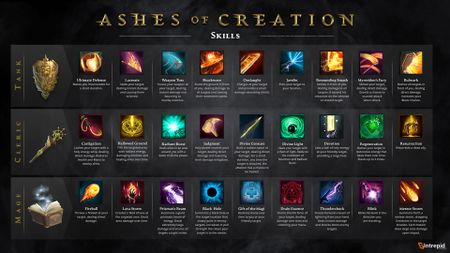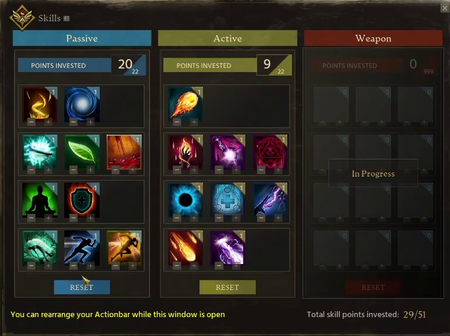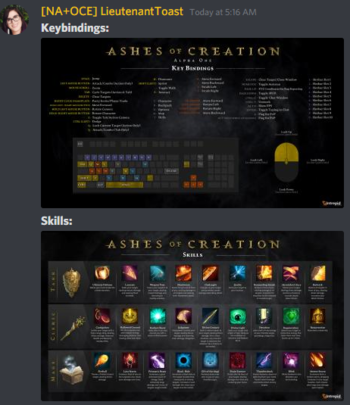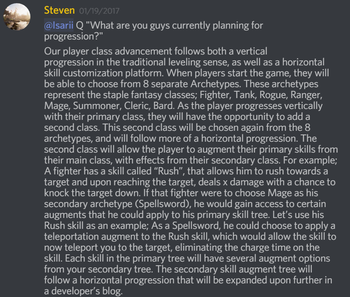Roles
| Icono | Arquetipo | Tipo.[1] | Rol.[2] |
|---|---|---|---|
| Bardo | Arcano | Apoyo | |
| Clérigo | Arcano | Apoyo | |
| Luchador | Marcial | Daño | |
| Mago | Arcano | Daño | |
| Arquero | Marcial | Daño | |
| Pícaro | Marcial | Daño | |
| Invocador | Arcano | - | |
| Tanque | Marcial | Tanque |
Ashes of Creation utiliza el tradicional sistema de la trinidad con los roles de Tanque, DPS y Soporte.[2][3]
- Aunque los papeles tradicionales están presentes, los jugadores no deberían sentirse encasillados por su arquetipo primario.[2][3]
- Los aumentos de habilidad disponibles a través del sistema de clases permitirán a los jugadores personalizar su estilo de juego fuera de su rol primario.[2][3][4]
- Los jugadores que elijan en mismo arquetipo dos veces, fortalecerán su rol primario.[2][3]
We have our eight base archetypes; and the trinity is a pretty strong influence with regards to the eight base classes. However the area in which we actually begin to play with that line between the trinity is in the secondary classes that you can pick. That's where we begin to blend those spaces and allow people a little bit of influence over their role and whether or not they fit perfectly within a particular category within the trinity.[4] – Steven Sharif
Balance
El equilibrio en Ashes of Creation está enfocado en el grupo, y no en el combate 1vs1"[5][6][7]
- Los enfrentamientos 1 contra 1 tendrán una dinámica tipo piedra, papel y tijera, donde una clase será superior a la otra.[5][7]
- There will be match ups in 1v1s where one class will be superior to another; and that application should be a rock-paper-scissors dynamic. We want there to be counter-play between the different classes... Instead it's going to be a group focused balance, where as long as you have the diversity of classes present, that's going to be an equal level playing field. It's going to be very dependent on skill and strategy.[7] – Steven Sharif
- A la hora de equilibrar las habilidades de combate entran en juego varios factores.[8]
- Balance-wise, there's a number of different interactions mechanically that you have within an ability that you can adjust in order to balance its power. The most most common ones are: Cooldown, Mana consumption, Damage done, Effect status conferred, Promotion of that effect status, Range.[8] – Steven Sharif
- El testing de la Alpha 1 se centró en la funcionalidad principal en lugar del equilibrio de combate.[9]
- Las pruebas en la Alpha 2 comenzarán a centrarse en el equilibrio una vez que las poblaciones y los conflictos estén funcionando y muy probados.[5][10]
- When we move into Alpha 2 and we have a lot of data that's supporting the use of these particular abilities in combat settings, how often they're used, how often they result in death, what the average damage done by this archetype is comparatively to other damage done by different archetypes: All of that data gets logged and all of that data gets queried in order for us to refine the abilities so that they live in the environment we want them to. Now, that's not to mean that we're going to have a perfect balance across the board between the archetypes. Again, we're taking a rock-paper-scissor approach to balance, which means that some archetypes will do better against other archetypes and vice versa; and we're also not creating an environment where we want to have 1v1 balance. We are focused around group balance. Group composition is important.[5] – Steven Sharif
Las sesenta y cuatro (64) clases están divididas en ocho arquetipos primarios. El equilibrio de las habilidades activas solo hace referencia a estos ocho arquetipos primarios. [6][11]
- Hay cuatro grupos primarios de aumentos asignados a cada arquetipo base. El equilibrio de estos aumentos hace referencia a los cuatro grupos de aumentos para cada uno de los ocho arquetipos.[12][13][14][11][15]
Ciertos arquetipos secundarios son capaces de reducir las diferencias frente a sus "counters".[16]
- Even though augments do radically change the way your active skills provide you abilities, there's still a primary focus on the base archetype itself and not the 64 whole classes.[6] – Steven Sharif
- Certain archetypes are capable of moving the gap between their counterpart per-se. If I am a Tank archetype and a Mage is my counter, I can take a Mage secondary and bridge the divide slightly; and then move my identity that direction ever so slightly.[16] – Steven Sharif
Habilidades de clase

Si elijes uno de los ocho arquetipos secundario, sea cual sea, vas a recibir una selección de aumentos que se relacionan con algunas de las ideas principales de esa clase. Ya sabes, como un tanque se centra en controlar el campo de batalla, en sobrevivir. El mago trata de infligir daño y usar los elementos y habilidades en área. El pícaro se centrará en el sigilo y el daño crítico. Por lo tanto esos aumentos van a jugar con esas identidades.[18] – Steven Sharif
La idea detrás de este sistema, es que estás tratando de bordear la línea de esos aumentos en tu rol, ¿Verdad?. Tenemos la clásica santísima trinidad que está presente en los diseños de las clases para los MMOs y, a menudo, no se desvían en absoluto de ella o bien se desvían completamente. El aumento sirve para ofrecer un equilibrio mediante el cual mantienes la apariencia de ese sistema mientras ofreces la oportunidad de personalizar tu experiencia de juego hacia uno de los otros lados del triángulo..[19] – Steven Sharif
Las habilidades primarias (habilidades de clase) están basadas en el arquetipo del jugador.[20] Los jugadores pueden personalizar sus habilidades primarias con el aumento de un arquetipo secundario[14][20][21]
- The design behind augments is to not just change the flavor so that it reflects the secondary archetype, but it also fundamentally changes the core components of a skill.[22] – Steven Sharif
- Cada arquetipo secundario ofrece cuatro escuelas de aumento diferentes.[12][13][14][15] Cada escuela de aumentos afecta a las habilidades primarias de un arquetipo de forma distinta.[23]
- Por ejemplo: Un Mago ofrece aumentos de teletransportación y escuelas elementales. Estos aumentos afectarán las habilidades primarias de un Luchador de forma distinta que a las de un Clérigo.[14][23]
- Cada aumento tiene un requisito de nivel.[24]
- Los aumentos no tienen un coste en puntos de habilidad.[25] Anteriormente se había afirmado que ciertos aumentos requerirán más puntos de habilidad que otros.[24]
- There's going to be a certain threshold at which you can no longer augment your active abilities based on the decisions you've augmented previous abilities, so you'll have to pick and choose which ones you want to apply the augments towards.[24] – Steven Sharif
- Los aumentos a las habilidades primarias cambiarán fundamentalmente la forma en la que funciona dicha habilidad: Adaptará aquello que la habilidad hacía para incorporar la identidad del arquetipo secundario.[27]
- El sistema de progresión para los aumentos es muy similar al sistema de progresión de clases.[28]
- Para cambiar los aumentos de tus habilidades, deberás ir a un NPC en un nodo de nivel Aldea o mayor.[29]
- Algunos colores y efectos especiales|FX pueden cambiar dependiendo de los aumentos elegidos.[30]
- Las habilidades activas pueden verse completamente diferentes después de que se les ha aplicado un aumento.[31]
- Fuera de las habilidades específicas de cada clase puede haber un subconjunto de habilidades universales, como Bloqueo activo y Esquivar.[32]
Se espera que las habilidades primarias en el Alpha-2 sean muy diferentes a las del Alpha-1.[33]
- The ability list in Alpha One is nowhere near what the ability list will be, especially from like a level/progression standpoint. So you can expect it to be incredibly different.[33] – Steven Sharif
Aumentos de clase
A player may choose a secondary archetype when they reach level 25.[34][14] Each secondary archetype offers four different schools of augmentation.[12][13][14][15] Each augment school affects a primary archetype's skills in different ways.[23]
- For example: A Mago offers Teleportation and elemental schools of augments. These augments will affect a Fighter's primary skills differently than a Cleric's.[14][23]
- When you reach the class phase, which is around level 25 and you introduce that secondary archetype selection to create your one of 64 classes, then you'll have a number of augments that you'll be able to apply on a per-ability basis; and your core ability kit comes from your primary archetype selection; and those augments will change the look and feel of those abilities; and some will have the affect to create more darker thematic aspects to it. Or just generally different aesthetics to the abilities that represent the secondary [archetype] selection.[34] – Steven Sharif
- The player can then augment their primary skills with effects from their secondary archetype.[35][36][34][14][20]
- The intent behind the augment system is not to provide new active abilities. They're intended to augment existing active abilities that are provided through your primary archetype; and so your secondary archetype selection completes your class selection, of which there's 64 types and you get augment skills that can apply certain attributes and mechanics to your existing active skills. So, if you have certain abilities, like a backstab as a Rogue primary archetype, and you take that healer secondary archetype selection, now the properties of your backstab will still remain the same as an active ability, however it might include things like life steal, or it might include things like susceptible weakness to the target, and reduces their healing because the definition of what those augments are intended to provide based on the archetype selected for the augments is within the schools of magic that live for that archetype: so a Cleric is about balancing life and death and the control of those types of hit points.[35] – Steven Sharif
- Each skill in the primary tree will have several augment options from the secondary tree. This is an example of horizontal progression.[20]
- The progression system for augments is very similar to the class progression system.[28]
- Augments to primary skills can fundamentally change the way the ability works - adapting what the ability once did to incorporate the identity of the secondary archetype/class.[27]
- Augments do not cost skill points.[25] It was previously stated that certain augments will have more expense required on the skill point side.[24]
- There's going to be a certain threshold at which you can no longer augment your active abilities based on the decisions you've augmented previous abilities, so you'll have to pick and choose which ones you want to apply the augments towards.[24] – Steven Sharif
- Secondary archetype augments allow different aesthetics to apply to primary abilities that reflect the secondary archetype selection.[34]
Puntos de habilidades

This is where players allocate skill points into either their active skills, their passive abilities- which can augment their usage of weapons and armors and health regeneration and passive stats and stuff like that-- but on the weapons side of things, that's where you will spec into certain types of procs based off of weapon groupings. So we've talked a little bit about this in the past: If you have a dagger, daggers might have a chance to proc a bleed on your weapon attack and that would synergize with an active skills' ability like let's say Backstab that does additional damage if the target is under a bleed effect. Now we have said in the past that players will be able to allocate skill points into their active skills that are more geared towards either action combat or tab targeting.[38] – Steven Sharif
Los jugadores obtienen puntos de habilidad conforme suben de nivel. Estos pueden ser usados para mejorar habilidades (subir su rango) ya sea en el árbol de habilidades activas, pasivas o de combate/armas.[39][40][41][42]
- No será posible subir al máximo todas las habilidades de árbol.[42]
- En cuanto a la progresión de habilidades, los jugadores pueden elegir entre "ir horizontal" y conseguir una serie de habilidades diferentes, o "ir vertical" con unas pocas habilidades específicas.[43]
- Los jugadores pueden resetear y reasignar sus puntos de habilidad.[44]
- Los aumentos no cuestan Puntos de habilidad.[25] Anteriormente se había dicho que algunos aumentos requerirán más gasto en puntos de habilidad.[24]
- Making active skills capable of receiving additional skill point allocations and unlocking additional features so that from a player agency standpoint it's going to be up to you whether or not you want to be more diverse but less depth- wider and not taller, in some of these skill choices. Or if you want to be very very tall, that's going to be something that is up to the player in that regard.[45] – Steven Sharif
Equipo óptimo (Best in slot)
- Los objetos crafteados estarán a la altura de los objetos BiS (best-in-slot)) (de drops).[46]
- Lo que se considera como BiS dependerá del rol del personaje y del tipo enemigos a los que se enfrente.[47]
- El contenido instanciado incluirá combates con jefes difíciles y con mecánicas que soltarán equipo, pero este equipo no será BiS. Este solo podrá ser encontrado en el mundo abierto.[48]
Synergies
Synergies exist between class skills, weapon skills, passive skills, proc effects, and status conditions.[49][50][51][52][53][54][55][56][40][41][57][27][58] These synergies also apply to active skills from other characters.[49][39]
- Q: How much do you intend for those sort of synergy things to be done within one class, one character's kit, versus how much do you intend for them to be working with the other characters, the other archetypes and specializations to promote their things, or to also make sure you don't step on their feet and accidentally promote something they're trying to maximize?
- A: When we talk about status conditions or keyword conditions and the promotion of those effects, there is going to be the bread and butter that each class kid has access to; and when they're creating the type of rotation with their ability system, they're going to want to emphasize those interactions that amplify or promote a particular type of status condition. So they'll have within the kit to their own interactions that they'll be able to leverage. But then in addition to that, they're going to have keyword status effects that help to either promote other classes' keyword status effects, or are the executed promotions of other classes initial status conditions. And when you think about the intent of the design: the intent of the design is that players are servicing themselves from a solo perspective when they want to go out and solo grind and solo experience and fulfill the quests. But when they come together to form a party to encounter group content, or a raid to encounter raid content: that the interconnectivity between those classes synergizes with these keyword promotions and/or effects; and there's a way to execute on that, that is successful and is effective, or a way that's not. And that's the skill ceiling/skill cap that requires interaction and cooperation and synchronization between, because there are limited time windows in which those keywords can get emphasized or executed upon when utilizing the ability.[49] – Steven Sharif
- When you think about it, it's very much a musical endeavor. When you think about a symphony or a concert, those instruments working with eachother to formulate this highly effective and very visceral experience of this music chain. When you accomplish that in combat, it's going to be noticeable; and that's the desire, is let's reward- let's dopamine hit when players are effective in their skill when executing on these ideas.[59] – Steven Sharif
Meta
La eficacia de las clases, habilidades y equipo dependerá del adversario o del reto. Habrá builds óptimas para diferentes retos y grados de dificultad. Este diseño pretende evitar que hay un meta evidente o que haya muchas builds cortadas por el mismo patrón en Ashes of Creation.[60]
- Los diferentes desafíos se presentan a los jugadores de forma dinámica en función de la progresión y destrucción del nodo. Las situaciones que se basan en un diseño tipo piedra-papel-tijera motivarán a una búsqueda de equipo horizontal. Estos desafíos dinámicos cambiarán de un mes a otro, provocando un cambio en la demanda de la economia a medida que el nuevo contenido requiera diferentes builds.[60]
- Los niveles de dificultad crecientes inspiran una progresión de poder vertical más tradicional, común en otros MMO.[60]
Oftentimes you just have a very vertical power scale and that determines chase, but when you have a variety of relevance across certain types of adversaries and that variety changes over time because of player activity- and then that affects the economy and the crafter system and who was producing what for what demand- and everything gets shaken up. That's a very fun environment to exist in. It presents a more dynamic situation rather than a quote-unquote cookie-cutter type selection.[60] – Steven Sharif
Ver además
Referencias
- ↑ Entrevista, 2020-07-29 (49:53).
- ↑ 2.0 2.1 2.2 2.3 2.4 Group dynamics blog.
- ↑ 3.0 3.1 3.2 3.3 Transmisión en vivo, 2017-05-22 (46:04).
- ↑ 4.0 4.1 Entrevista, 2018-10-20 (2:40:16).
- ↑ 5.0 5.1 5.2 5.3 Transmisión en vivo, 2023-12-19 (1:25:16).
- ↑ 6.0 6.1 6.2 Transmisión en vivo, 2020-10-30 (33:26).
- ↑ 7.0 7.1 7.2 Pódcast, 2018-04-23 (59:28).
- ↑ 8.0 8.1 Transmisión en vivo, 2023-12-19 (1:23:00).
- ↑ Transmisión en vivo, 2021-05-28 (1:13:05).
- ↑ Transmisión en vivo, 2022-12-02 (1:05:51).
- ↑ 11.0 11.1 Entrevista, 2018-10-20 (2:40:17).
- ↑ 12.0 12.1 12.2 Pódcast, 2021-09-29 (30:04).
- ↑ 13.0 13.1 13.2 Transmisión en vivo, 2021-06-25 (1:05:01).
- ↑ 14.0 14.1 14.2 14.3 14.4 14.5 14.6 14.7 Entrevista, 2020-07-18 (1:05:04).
- ↑ 15.0 15.1 15.2 Transmisión en vivo, 2018-02-09 (41:56).
- ↑ 16.0 16.1 Pódcast, 2018-04-23 (1:01:01).
- ↑

- ↑ Transmisión en vivo, 2017-10-16 (1:00:44).
- ↑ Entrevista, 2018-08-08 (22:27).
- ↑ 20.0 20.1 20.2 20.3

- ↑

- ↑ Transmisión en vivo, 2020-07-25 (1:47:55).
- ↑ 23.0 23.1 23.2 23.3 Transmisión en vivo, 2019-12-17 (1:13:14).
- ↑ 24.0 24.1 24.2 24.3 24.4 24.5 24.6 Entrevista, 2020-07-18 (1:07:06).
- ↑ 25.0 25.1 25.2 Forums - Livestream Q&A 2022-08-26.
- ↑ 26.0 26.1

- ↑ 27.0 27.1 27.2 February 8, 2019 - Questions and Answers.
- ↑ 28.0 28.1 Transmisión en vivo, 2019-07-26 (1:09:22).
- ↑ 29.0 29.1 Transmisión en vivo, 2018-04-8 (PM) (20:45).
- ↑ 30.0 30.1

- ↑ 31.0 31.1 Entrevista, 2018-05-11 (53:15).
- ↑ Transmisión en vivo, 2021-11-19 (50:38).
- ↑ 33.0 33.1 Transmisión en vivo, 2021-09-24 (1:18:06).
- ↑ 34.0 34.1 34.2 34.3 Transmisión en vivo, 2023-07-28 (1:04:27).
- ↑ 35.0 35.1 Transmisión en vivo, 2024-01-31 (5:00).
- ↑ Transmisión en vivo, 2023-12-19 (1:20:41).
- ↑ Transmisión en vivo, 2021-06-25 (23:08).
- ↑ Transmisión en vivo, 2020-08-28 (1:12:50).
- ↑ 39.0 39.1 Entrevista, 2020-07-29 (55:44).
- ↑ 40.0 40.1 Entrevista, 2020-07-19 (53:59).
- ↑ 41.0 41.1 Entrevista, 2020-07-18 (1:07:51).
- ↑ 42.0 42.1 Transmisión en vivo, 2017-07-28 (19:05).
- ↑ Transmisión en vivo, 2017-11-16 (30:02).
- ↑ Entrevista, 2020-07-29 (54:44).
- ↑ Transmisión en vivo, 2020-08-28 (1:19:24).
- ↑ Transmisión en vivo, 2017-05-10 (14:45).
- ↑ Transmisión en vivo, 2020-05-29 (1:33:11).
- ↑ Transmisión en vivo, 2022-03-31 (1:19:41).
- ↑ 49.0 49.1 49.2 Entrevista, 2023-07-09 (1:14:09).
- ↑ Transmisión en vivo, 2022-12-02 (56:09).
- ↑ Transmisión en vivo, 2022-06-30 (1:12:38).
- ↑ Transmisión en vivo, 2022-09-30 (53:15).
- ↑ Transmisión en vivo, 2022-09-30 (43:45).
- ↑ Vídeo, 2022-09-30 (24:49).
- ↑ Pódcast, 2021-09-29 (47:57).
- ↑ Entrevista, 2021-02-07 (49:18).
- ↑ Transmisión en vivo, 2020-01-30 (1:28:40).
- ↑ Transmisión en vivo, 2018-06-04 (1:11:19).
- ↑ Entrevista, 2023-07-09 (1:16:45).
- ↑ 60.0 60.1 60.2 60.3 Pódcast, 2021-04-11 (54:35).